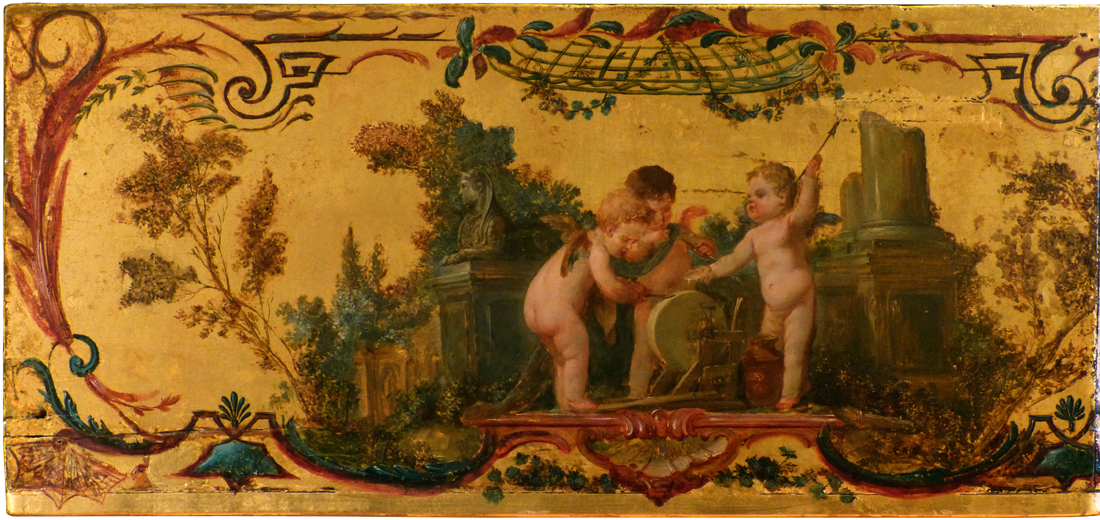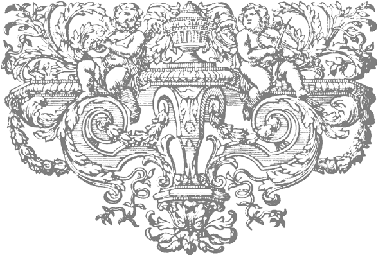
The history and restoration of this stunningly-beautiful double-manual harpsichord.

The decoration of the cheek of the harpsichord by Frans van Huffel. This is one of the scenes painted around the sides
of the harpsichord, and is part of the 'Triumph of Love' sequence. The putto on the right is providing 'water', presumably
from the jug between his legs, which he is filling in a highly unusual way! This scene is clearly from the hand of the
most famous, and most important French painter of the 18th century: Francois Boucher!
Here you will find the details of an amazing Franco-Flemish double-manual harpsichord. Research that the author has carried out recently shows that this superb instrument was made in Antwerp by Frans van Huffel in 1617. It can be stated with confidence that this instrument is not by any of the members of the Ruckers family.
This harpsichord was given an initial bass ravalement in Paris sometime between 1742 and 1750, by an unknown maker. It then received some major alterations in Paris in 1750 to both its musical and to its decorative state. At this time the exterior was lavishly decorated by the famous French artist, François Boucher, who was the Court Painter to Louis XV, and who is still the most celebrated French painter of the 18th-century. The alterations to the instrument carried out in 1750 show that it was given a bass ravalement by the well-known harpsichord maker François Étienne Blanchet, facteur des clavessins [sic] du roi (harpsichord maker to the king) to increase the compass from G1/B1 to c3, to F1 to d3.
Archival evidence shows that Boucher and Blanchet worked together on many other occasions during the period around 1750, also including numerous projects for Louis XV. Among these was the ravalement of the van Huffel harpsichord. Many of these projects were commissioned for the King by Louis' grande maitresse (principal mistress), Madame de Pompadour. The painting of the scene found on the interior of the lid (see the image below) is, however, attributed to Jean-Baptiste Le Prince, a pupil of François Boucher. Archival evidence indicates that Le Prince began working with Boucher in 1750, exactly the same date as that of the Blanchet ravalement of the harpsichord. It therefore seems likely that this internal lid painting is the first work carried out by Le Prince. Later, in 1786, it was given a further treble ravalement by Jacques Barberini and Nicolas Hoffman, also in Paris. This final ravalement extended the treble compass from d3 up to f3.
This outstandingly-beautiful double-manual harpsichord has been shown by scientific metrology of its measurements to have been designed and built using units of the Antwerp duim (thumb) and the Antwerp voet = foot, which are the units of measurement used historically in Antwerp. What is unusual about the Antwerp system is that, historically, there were 11 inches (duimen) in one voet and not 12 as used in most other European countries. The duim and the voet are used throughout in this instrument to a very high level of accuracy. The use of this unit of measurement therefore indicates clearly that the harpsichord was designed and built in Antwerp. Separate analyses also show that the harpsichord started life as a relatively simple 'transposing' harpsichord made in 1617, the date given in all of the early records of the instrument.
According to the records of the Guild of St Luke in De Mededelingen van het Ruckers Genootschap, Frans van Huffel was the only active harpsichord maker working in Antwerp in 1617 other than Ioannes and Andreas Ruckers. However, many features of the instrument indicate clearly that it was not made by either of the two Ruckers brothers. This harpsichord can therefore confidently be attributed to Frans van Huffel, the only harpsichord-making member of the Guild of St Luke in 1617 if we exclude the brothers Andreas and Ioannes Ruckers.
Analysis shows that, at some date between 1742 - 1750, the harpsichord underwent its first ravalement. This process widened the case, increasing the bass compass down to F1. Then, in 1750, it received new keyboards, and new registers and jacks made by the Parisian harpsichord maker François Étienne Blanchet (who later became the court harpsichord maker to Louis XV). These alterations increased the compass to F1 to d3.
In 1750 it was also given its exceptionally lavish decoration by François Boucher. There is probably no other 18th-century French harpsichord with a finer, more elegant nor more beautiful decoration that that found on this instrument. After 1750, the harpsichord was given a final grand ravalement in Paris in 1786 by Jacques Barberini and Nicolas Hoffman, who are otherwise unknown among 18th-century French harpsichord makers. These two extended the treble compass from d3 up to f3., but any additional work they might have done has been obscured by 19th- and 20th-century uninformed 'restorations'. The fourth register, already present in its physical form, was added at this time as part of the whole ensemble and was quilled in peau de buffle. Barberini and Hoffman also gave the harpsichord new keyboards with a compass of F1 to f3 as well as new registers and new jacks. It then had the usual French grand ravalement 5-octave compass with four registers including 2x8', 1x4', a near-plucking nasal, and a peau de buffle register, as well as a unique expressive genouillère, of a type not found on any other French 18th-century harpsichord known to the author.
![]()
|
|
It seems highly likely that this harpsichord was initially given its extravagant decoration simply because of its stunning, beautifully rich sound. It is, indeed, still today, perhaps the finest-sounding instrument in the entire history of French harpsichord making. Almost certainly because of its outstanding sound, it seems to have found its way into the musical life of the French Court at the time of Louis XV, and to have played an important role in the social and musical life there. The harpsichord was later given a final grand ravalement in 1786 by Jacques Barberini and Nicolas Hoffman in Paris. These two makers, who are otherwise virtually unknown except for their intervention to this instrument, widened the case in order to give it a new treble compass from d3 up to f3. They seem also to have added a peau de buffle register and a unique genouillère. This meant that the harpsichord then had the usual French grand-ravalement 5-octave compass with four registers including 2x8', 1x4' all in quill, and the delicate peau de buffle to contrast with the other registers in quill. It was also given a unique genouillère with a mechanism to swell and diminish the sound of the whole ensemble. Unfortunately this genouillère was removed, probably by Arnold Dolmetsch in the early 20th century and, most unfortunately Dolmetsch left no trace of the historical genouillère nor of how it worked. It has therefore not been possible to replace or to reconstruct it in the course of the present restoration. The stand, which has never been enlarged and therefore fits the case as it existed in 1786. The history of the instrument between 1786 and 1883 is unknown. This harpsichord has one of the finest, richest, most harmonious, and most even sounds of any French 18th-century harpsichord in the world! Click on the images and links below and at the bottom of this page to see more images and some highly-detailed information about this splendid instrument. |
Some of the modern history of the instrument
The instrument has also had an amazing modern history ranging across much of Western Europe, the United States and South America. This episode in it's history also includes many of the important figures who took part in the modern harpsichord revival. As a result, it therefore turns out to be a very important document in the history of the modern revival of interest in the harpsichord and its music. Shortly before 1889 it was restored by Louis Tomasini in Paris, and was played in the concerts given by Louis Diémer during the 1889 Exposition Universelle for which the Eiffel Tower was built. Its modern history also involves some highly-important political figures who influenced major world events - but not necessarily involving music nor furniture decoration!
![]()
Click on the images and links below for more information.
|
|
|
|
|
|
|
|
||||
|
|
|
|||
|
Click on this image to see details of the 1927 Sotheby's sale catalogue. |
||||
| The sections below relate to the scientific studies of the paintwork and decoration and to how these relate to the attribution of the various states and OF THE painter/decorators who worked on this instrument | ||||
|
|
Some important personalities in the French court around 1750. |
|||
|
The 4 images on the right all show clear evidence of the work of Francois Boucher in the decoration of the case of the instrument. However, the original sourcek of two of the images (No. 1 and No. 4) is Jean-Antoine Watteau. |
||||
| A large number of scientific analysis have been carried out on the paintwork of the instrument, including UV examination, IR photography, grazing light photography and numerous pigment-composition analyses. In addition a careful dimensional analysis has also been carried out in the course of the study and restoration of this instrument, and this has been published as a technical drawing. | ||||

The second image of the "Victory of Love" sequence surrounding the whole of the vertical outside panels of the case of the instrument.
The liquid lubrication used in the sharpening process seems not to be just water, but was collected from the jug between the legs of the
right-hand putto where it can be seen here in the process of being re-filled!!
![]()
Listen to the sound of this splendid instrument here - we strongly recommend that you use good quality
earphones to listen to the instrument in order to get the full resonance of the sound!
![]()
![]()
![]()
A brief history of the musical and decorative states of the Franco-Flemish harpsichord
![]()
Details of
the original state of the instrument
![]()
Details of the eighteenth-century states of this harpsichord
Details of the modern history of this harpsichord
![]()
Problems encountered in the ethical restoration of this harpsichord
![]()
This page was last revised on 10 December 2025.
